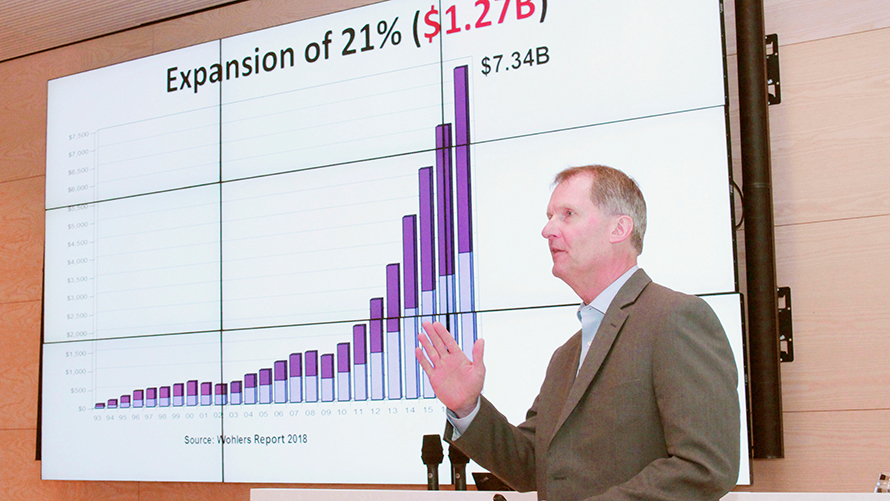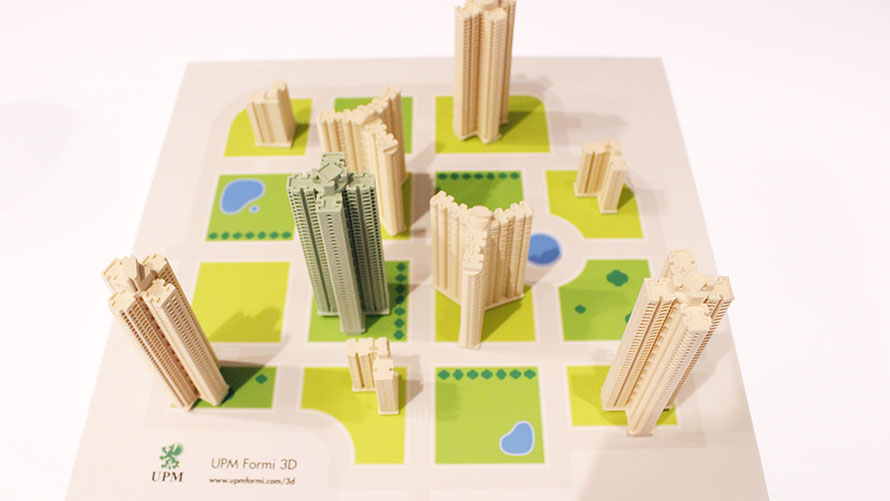First off, additive manufacturing (3D printing) is growing at a steady rate. The challenge of the industry is scaling the bright ideas and innovative prototypes into actual profitable business! UPM’s interest in 3D is strong as UPM Biocomposites has just launched UPM Formi 3D printing material at the Nordic 3D Expo, a yearly event attached to the FIRPA conference. UPM Formi 3D brings the unique functionality and aesthetic qualities of cellulose fibres to 3D printing. The printing material has a matte feel, versatile colour possibilities, and it can be sanded and painted like wood. It functions in both detailed prints and in large scale applications, the Leaf Bridge prototype being an example of this. The material has self-supporting molten state properties which make it especially well-suited for large scale 3D printing as it cools off and thus finds its form much faster than many other materials. Because of this the material is relatively easy to print even if the printer doesn’t have the most effective cooling system.
According to Wohlers, the 3D printing industry has seen a surge of new materials and material suppliers in the last decade. Thus, a 3D printing material must have unique properties and application possibilities in order to gain a share of the busy market. “UPM Formi 3D is all about opening up new application possibilities for 3D printing with its unique properties. It works with a standard 0,4mm nozzle unlike many other wood-plastic composites on the market. With our product it’s not only about prototyping, the target is to produce end products for example in the area of industrial design,” says Eve Saarikoski, UPM Formi 3D expert and Application Manager at UPM Biocomposites.
3D printers can be classified as desktop models or industrial models with desktop models costing around 1000 dollars and industrial models 50 000 dollars. In 2017 over 500 000 desktop models were sold and 14 000 industrial models. Printers that cost under 5000 dollars are classified as desktop models. The value of the materials market is estimated to be around 1 billion dollars divided between photopolymers, polymer powders, filaments, metals and other materials.

From prototyping to production through a new design perspective
A movement towards actual 3D large volume production instead of only prototyping is underway, says Wohlers, ”3D printing has been used for prototyping or molds for actual production for some time already but today the same 3D process is beginning to be applied to actual production. This is a significant change as it promises more continuity in the quality of production.”
The key in turning 3D prototyping into 3D production is defining the break-even point of amount of units and cost of production by 3D or by traditional casting.
”For one company it turned out to be 5000 in larger units and 25,000 for the smaller ones. 3D printing has major benefits as products can be made on demand, they can be modified and improved along the way and the lead time is better. But still, it’s largely about cost,” says Wohlers.
90 percent of the custom fit hearing aids used today are manufactured by 3D printing. The acetabular cups for artificial hips are another product often manufactured by 3D printing. Tailored eyewear, custom fit shoes or shoes with special soles are other applications of products manufactured by 3D printing.
In addition to many custom products that can only be manufactured by 3D printing, there are products that are special because their design can only be achieved by 3D printing.
”People love products that are unique. ”Only I have this”-type of products, like this 3D printed titanium pen”, says Wohlers pulling a pretty special pen out of his coat pocket.
Many products could reach the break-even point of 3D printing cost but only after being completely re-designed. There is no point in 3D printing screws and bolts when A 3D printed product does not need them.
”To benefit most from 3D manufacturing, the product’s design has to be completely new. This sort of thinking mostly doesn’t exist! With 3D you could calculate where material is actually needed in order to produce ultimately strong and lightweight structures. 75% savings in materials and 25% in product weight can be achieved. Not many people are fully aware of these possibilities,” Wohlers points out.
The challenges of the industry are not perhaps as widely known as the potential. ”The right people in the right industries see the potential of 3D printing but they don’t necessarily look at the challenges. How to automate the process? Can you automate it?” Wohlers points out.

Bio-based materials have to perform in order to succeed
Wohlers sees a strong potential market for bio-based 3D printing materials, but only if they perform just as well as the traditional plastics like PLA and ABS. ”There is a appetite for bio-based materials in the industry, but they have to perform as well as the properties of the traditional materials, ” says Wohlers.
A 3D printing material should first find a niche market where the properties of the product offer something unique, and grow from there. ”In biomedical applications, for example, the 3D printing materials have to be biofriendly. The hearing aids must be made out of materials that do not irritate the ear”, Wohlers points out.
UPM Formi 3D’s unique properties offer development possibilities in many fields. “Right now we are developing UPM Formi 3D’s large scale printing possibilities with filaments and granules. Large scale 3D printing is trending in the 3D industry and is a great point from which to develop our product further,” says Eve Saarikoski.
Saara Töyssy
Read more:
